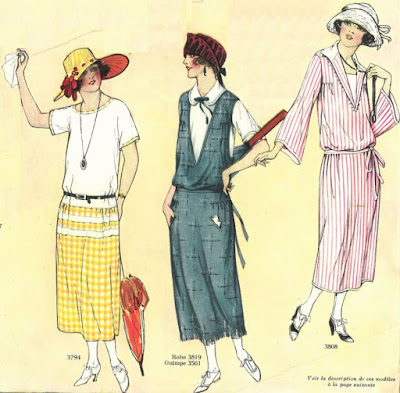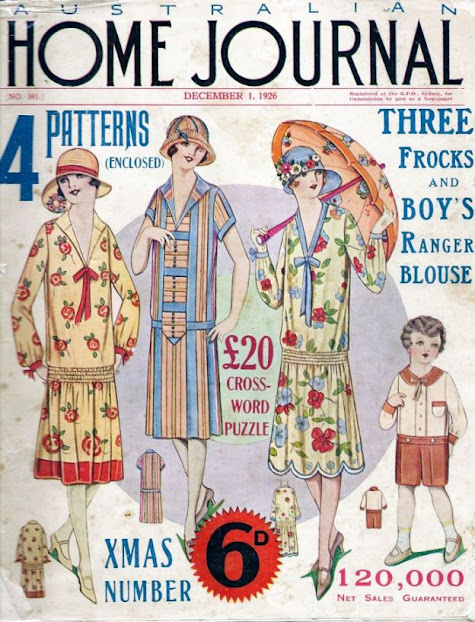By the 1920s the one-piece dress was a standard item in every woman's wardrobe, a position it held until the 1960s and beyond. It could be dressy or plain, worn at a garden party or wedding, or behind a counter or wielding a mop.
What I'm going to do over the next few weeks is look at spring and summer day dresses, year by year and decade by decade, to show how these garments changed over time. To begin with, the 1920s, age of flappers and jazz!
 |
| Butterick Quarterly, Spring 1920 |
To kick the decade off: a selection of summer dresses, all with mid-calf hems and waists either high or sitting at their natural levels. The hips are emphasised, either by cutting skirts wide at the top and tapering, or by use of peplums, panels or frills.
 |
| National Cloak & Suit Co., Spring-Summer 1921 |
Voile, organdie and gingham—this page illustrates a range of dresses at different prices. The two more expensive have matching overskirts to add bulk at the hips, while the gingham dress makes do with patch pockets! All dresses are sashed at the natural waistline.
 |
| Miroir des Modes, July 1922 |
By 1922 the waist has dropped to the top of the hip level, and dresses have become straighter (and shaped more like what we think of as the 1920s silhouette).
 |
| National Cloak and Suit Co., Spring-Summer 1923 |
Dress from 1923 are loose, roomy—and figure-concealing. Skirts are calf-length and gathered into unpressed pleats at the waist, which is now sitting on the hips!
 |
| Everylady's Journal, December 1924 |
By 1924, dresses are becoming slightly more straight and tubular, though still long and retaining some of their bulk from 1923. The dress on the left is crocheted—pattern included inside the magazine!
 |
| Miroir des Modes, June 1925 |
1925 sees the start of what we envision when we think of the 1920s. Hemlines are rising, and the silhouette is very straight and narrow.
 |
| Australian Home Journal, December 1926 |
 |
| McCall Style News, April 1927 |
McCall offers some very art deco styles in 1927—flat, geometric and streamlined. McCall lists the couturiers from whom it has bought models, a sign that these fashions are moving from the catwalks onto the streets.
 |
| Fashions for All, June 1928 |
Here we have 1920s fashions and their shortest and scantiest, with hems barely skimming the kneecap. Looking back a few years, these dresses appear to have used approximately half the material their 1923 counterparts did.
 |
| Mabs Fashions, August 1929 |
At the end of the decade a touch of femininity is creeping in. Belts are now positioned at the top of the hips, and there is the merest hint that the wearers of these dresses actually have figures! These clothes are still very much of the 1920s, but they are clearly poised for the really big changes we're going to see in the styles of 1930. But that's a topic for my next post!
No comments:
Post a Comment